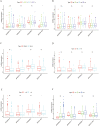A novel ferroptosis-related lncRNA signature for prognosis prediction in gastric cancer
- PMID: 34774009
- PMCID: PMC8590758
- DOI: 10.1186/s12885-021-08975-2
A novel ferroptosis-related lncRNA signature for prognosis prediction in gastric cancer
Abstract
Background: Gastric cancer (GC) is a common malignant cancer with a poor prognosis. Ferroptosis has been shown to play crucial roles in GC development. Long non-coding RNAs (lncRNAs) is also associated with tumor progression in GC. This study aimed to screen the prognostic ferroptosis-related lncRNAs and to construct a prognostic risk model for GC.
Methods: Ferroptosis-related lncRNAs from The Cancer Genome Atlas (TCGA) GC expression data was downloaded. First, single factor Cox proportional hazard regression analysis was used to select seven prognostic ferroptosis-related lncRNAs from TCGA database. And then, the selected lncRNAs were further included in the multivariate Cox proportional hazard regression analysis to establish the prognostic model. A nomogram was constructed to predict individual survival probability. Finally, we performed quantitative reverse transcription polymerase chain reaction (qRT-PCR) to verify the risk model.
Results: We constructed a prognostic ferroptosis-related lncRNA signature in this study. Kaplan-Meier curve analysis revealed a significantly better prognosis for the low-risk group than for the high-risk group (P = 2.036e-05). Multivariate Cox proportional risk regression analysis demonstrated that risk score was an independent prognostic factor [hazard ratio (HR) = 1.798, 95% confidence interval (CI) =1.410-2.291, P < 0.001]. A nomogram, receiver operating characteristic curve, and principal component analysis were used to predict individual prognosis. Finally, the expression levels of AP003392.1, AC245041.2, AP001271.1, and BOLA3-AS1 in GC cell lines and normal cell lines were tested by qRT-PCR.
Conclusions: This risk model was shown to be a novel method for predicting prognosis for GC patients.
Keywords: Bioinformatics; Ferroptosis; Gastric cancer; Long non-coding RNA; Prognosis.
© 2021. The Author(s).
Conflict of interest statement
There are no conflicts of interest concerning the publishing of this article.
Figures







Similar articles
-
Role of ferroptosis and ferroptosis-related non-coding RNAs in the occurrence and development of gastric cancer.Front Pharmacol. 2022 Aug 15;13:902302. doi: 10.3389/fphar.2022.902302. eCollection 2022. Front Pharmacol. 2022. PMID: 36046827 Free PMC article. Review.
-
Development and experimental validation of a senescence-related long non-coding RNA signature for prognostic prediction and immune microenvironment characterization in gastric cancer patients.J Gastrointest Oncol. 2024 Dec 31;15(6):2413-2436. doi: 10.21037/jgo-24-792. Epub 2024 Dec 26. J Gastrointest Oncol. 2024. PMID: 39816024 Free PMC article.
-
Integrated clinical characteristics and omics analysis identifies a ferroptosis and iron-metabolism-related lncRNA signature for predicting prognosis and therapeutic responses in ovarian cancer.J Ovarian Res. 2022 Jan 20;15(1):10. doi: 10.1186/s13048-022-00944-y. J Ovarian Res. 2022. PMID: 35057848 Free PMC article.
-
Ferroptosis‑related long non‑coding RNAs and the roles of LASTR in stomach adenocarcinoma.Mol Med Rep. 2022 Apr;25(4):118. doi: 10.3892/mmr.2022.12634. Epub 2022 Feb 9. Mol Med Rep. 2022. PMID: 35137922 Free PMC article.
-
Ferroptosis-related long non-coding RNA signature predicts the prognosis of hepatocellular carcinoma: A Review.Medicine (Baltimore). 2022 Nov 25;101(47):e31747. doi: 10.1097/MD.0000000000031747. Medicine (Baltimore). 2022. PMID: 36451456 Free PMC article. Review.
Cited by
-
Role of ferroptosis and ferroptosis-related non-coding RNAs in the occurrence and development of gastric cancer.Front Pharmacol. 2022 Aug 15;13:902302. doi: 10.3389/fphar.2022.902302. eCollection 2022. Front Pharmacol. 2022. PMID: 36046827 Free PMC article. Review.
-
Disulfidptosis-related LncRNA signatures in gastric cancer: regulation of MYH10-driven cytoskeletal remodeling and therapeutic implications.Discov Oncol. 2025 Jul 22;16(1):1385. doi: 10.1007/s12672-025-03160-4. Discov Oncol. 2025. PMID: 40694286 Free PMC article.
-
Development and experimental validation of a senescence-related long non-coding RNA signature for prognostic prediction and immune microenvironment characterization in gastric cancer patients.J Gastrointest Oncol. 2024 Dec 31;15(6):2413-2436. doi: 10.21037/jgo-24-792. Epub 2024 Dec 26. J Gastrointest Oncol. 2024. PMID: 39816024 Free PMC article.
-
Cuproptosis-related lncRNAs predict the prognosis and immune response in hepatocellular carcinoma.Clin Exp Med. 2023 Oct;23(6):2051-2064. doi: 10.1007/s10238-022-00892-3. Epub 2022 Sep 24. Clin Exp Med. 2023. PMID: 36153416
-
Ferroptosis: opening up potential targets for gastric cancer treatment.Mol Cell Biochem. 2024 Nov;479(11):2863-2874. doi: 10.1007/s11010-023-04886-x. Epub 2023 Dec 11. Mol Cell Biochem. 2024. PMID: 38082184 Review.
References
MeSH terms
Substances
LinkOut - more resources
Full Text Sources
Medical
Miscellaneous

